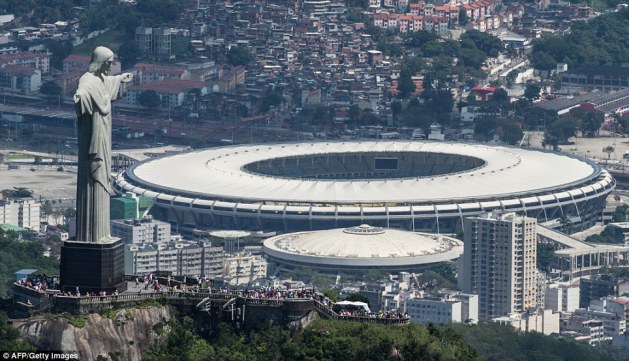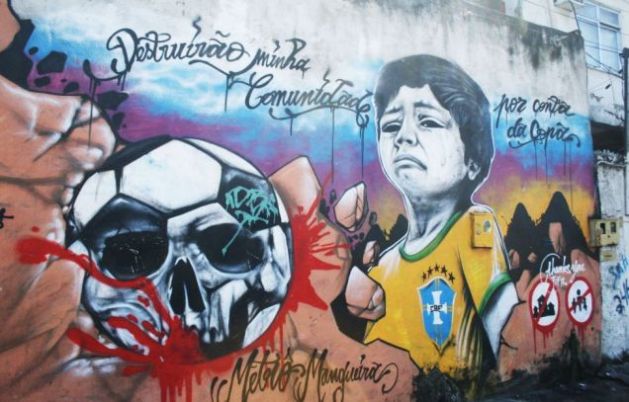By: Judy Park, Analyst
Mega-events such as the Olympics are not just time-honored international sports competitions. They are some of the truly global stages in the world today, with billions of viewers and dollars involved.
Eager for the international prestige and economic multipliers that come with such an event, countries often spend a fortune just to vie for the chance to host. Once they win the bid, a massive construction and redevelopment agenda kicks into high gear: monumental stadiums, transportation networks, airports, athlete housing, luxury hotels, and revamped tourist attractions. While this city-wide facelift generates benefits for the economy and tourism, it also threatens the livelihoods of urban residents already suffering from poverty and marginalization. The rapid pace of development often results in forceful “beautification” programs, soaring housing values, and a lack of due process in relocation efforts.
Brazil, the envied host of this summer’s World Cup and the 2016 Olympics, is a ready example of this phenomenon. The country has already channeled $4 billion into preparing its cities for the limelight. However, in the process, the government has already displaced 19,000 families from Rio de Janeiro’s well-known favelas, attracting calls of “social cleansing” in the process. Although city officials claim that they have faithfully adhered to established expropriation guidelines, residents say otherwise. In addition, it is often the case that even when better physical housing might be offered, residents do not want to move away from the social and economic networks they have built over their lifetime.
Interestingly, Brazil’s oft-decried favelas are also being touted as cheap accommodation for World Cup attendees and an opportunity to experience the “real Rio de Janeiro” through “one of the city’s most fascinating and vibrant communities.”
Theresa Williams, director of Catalytic Communities, notes the dissonance between these two images of the favelas:
“[In the runup to the World Cup] international media are presenting Rio’s favelas either as violent no-go areas or cheap places for tourists to stay. They can’t be both, so which is it?” says Williamson. Rio’s favelas could not only offer a model amid the growing need for affordable housing worldwide but enhance a city already famed for its natural beauty with 600 unique communities with distinct cultures, she says. (Link)
(By the way, we at AHI agree that the urban slum is where the solution to global affordable housing crises begins.)
The negative impact of mega-events on local communities is not new. A study by the Centre on Housing Rights and Evictions (COHRE) highlights the consequences of Olympic events on housing in six cities over the past two decades:
- 1988, Seoul: 720,000 people evicted from 48,000 buildings, where 90% of those evicted did not receive replacement housing and most were forced out using violent methods.
- 1992, Barcelona: Houses prices rose by 250%, making housing unaffordable to many residents and forcing them to leave the city.
- 1996, Atlanta: Country’s oldest public housing complex, Techwood Homes, redeveloped as the first mixed income HOPE VI community, but net loss of 800 public housing units and minimal relocation assistance during redevelopment. 9000 arrest citations given to homeless people in 1995-1996 as part of city-wide “clean-up.”
- 2000, Sydney: Real estate speculation led to eviction of residents. Gentrification accelerated and number of homeless tripled over five years.
- 2004, Athens: Games were used as pretext for displacing Roma communities. 2,700 Roma were forcibly evicted.
- 2008, Beijing: 1.5 million people displaced over a period of 8 years.
In order to mitigate the costs of any future mega-events, COHRE lays out some “best practices” for bidding and preparing for the Olympics, including: regulating the involvement of the private sector, local community participation in decision-making, public commitments to housing preservation, protection protocols for minorities and the homeless, housing rights legislation, housing-positive regeneration strategies, strong community activism, and the post-Olympics use of venues for social housing. A good example of the last point occurred in 2012, when it was announced that nearly half of London’s Olympic village would be transformed into affordable rental units to ease the city’s housing shortage.
What do you think about the impact of mega-events on housing? What should be done to address this issue? Please let us know in the comments below!
Image Sources
- http://www.dailymail.co.uk/sport/worldcup2014/article-2611094/More-World-Cup-concerns-Brazil-Rio-favela-riots-break-just-50-days-tournament-kick-offs.html
- http://metro.co.uk/2012/04/23/how-the-build-up-to-the-world-cup-and-olympics-is-affecting-rios-favelas-406668/
- http://www.thenation.com/blog/179077/brazils-world-cup-gentrification-through-barrel-gun
- http://favelaexperience.com/#rio-de-janeiro-apartment-rentals
- http://inhabitat.com/londons-2012-olympic-village-to-be-transformed-into-affordable-housing-units/






Here are some further perspectives to consider on these issues, from AHI’s CEO David Smith:
On Rio’s favelas and public consultation:
http://affordablehousinginstitute.org/blogs/us/2014/03/zenos-public-consultation-paradox-part-1-longer-than-the-time-available.html
“When it comes to public-consultation processes, there is never enough time to achieve consensus…here is the Zeno’s paradox of public-approval processes: no matter how much time the public sector budgets for its consultation and approval processes, it will always use more than that amount of time, until time runs out, the bulldozers have to roll, and the government ends up forcibly evicting people whom it had set out to protect, all the while saying (and believing) that it is doing the right thing, acting honorably and for the poor people’s own good.”
On the Atlanta case:
“That property was a notorious slum known as Techwood Houses, in horrible physical condition, and after the Olympics it became the country’s first HOPE VI property, Centennial Place. http://www.mccormackbaron.com/component/sobi2/?sobi2Task=sobi2Details&catid=2&sobi2Id=85. So the Olympics were the catalyst to revitalize a failed public housing property, and to spark the revitalization of downtown Atlanta. So it’s not a displacement example, quite the reverse.
All residents had a right to return. Many of them chose not to. Many of the 1,196 public housing units were uninhabitable or cannibalized. The eviction count starts in 1990 and the deal wasn’t developed until 1994. The pre-94 evictions were for good cause. See also: http://affordablehousinginstitute.org/blogs/us/2008/11/history-of-us-public-housing-part-6-the-hope-revolution.html.
Finally, I believe that the ‘residents reported’ statements about AHA’s motives are just wrong, conveniently self-exculpating. See http://affordablehousinginstitute.org/blogs/us/2008/10/history-of-us-public-housing-part-5-the-cities-hit-bottom.html.”
Pingback: Slummin’ it at the 2014 FIFA World Cup | Affordable Housing Institute – Global Blog